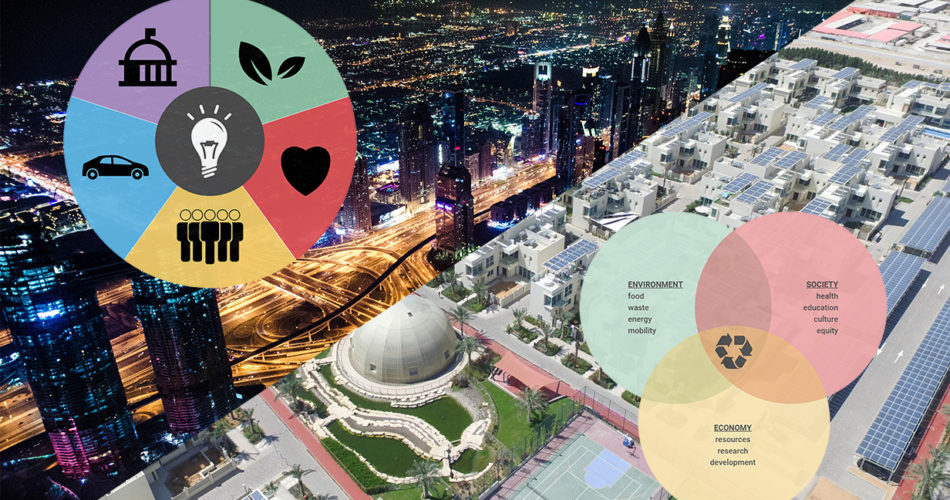Technology brings us back to our essential needs
We often confuse and consider these two terms the same thing but they are actually not synonymous: I’m talking about the difference between a smart city and a sustainable city.

In recent years, the internet of things (IoT), the evolution of smartphones, and the resulting intensive development of apps for a wide variety of uses have increased the number of smart devices which are connected to the network and managed by phones with special apps, even where there was no a home automation setup.
We moved from remote management of little devices such as light bulbs, sockets, sensors, etc… To bigger ones such as air conditioners, washing machines, refrigerators, etc… Including smart toilets.
The smart evolution has not, however, been confined inside our homes, because even outside, such devices, such as those for security, have widely expanded: think about those ranging from traffic analysis, fire detection, air quality, facial recognition systems, etc…
In addition, more efficient management of energy resources has been developed by using, not only renewable energy and energy containment systems but also by reusing waste products as a new product for creating a more circular use of the available resources.
Beyond those obvious aspects, a smart city must be populated by smart citizens too, who are aware and able to manage resources smartly. All along with an administration of territory that has a central role: both at the level of accessibility and data exchange controlled by the same eco-system but also through the collaboration of the people.
Key aspects such as health, culture, education, and security, must be guaranteed to the citizens, in order to ensure well-being and comfort, if we want to achieve the concept of smart living.
In addition, in order to achieve energy efficiency and lower environmental impact, smart mobility management cannot fail, intensifying public transport, encouraging e-mobility, and sharing mobility for example.
So a smart city can be sustainable but it’s not its main aim because it’s more focused on the technological management of the most important aspects of the city such as transport, security, facilities, services, etc…

A sustainable city, on the other hand, aims more for a better quality of life, achievable through the optimization of resources, care for the environment, and the reduction of waste by aiming at circularity. In this sense, many of the devices used by smart cities serve the purpose of a sustainable city (transport, energy efficiency, etc…) but the aims are different and more green-oriented.
It may sound like a contradiction but a sustainable city resides right in the homeland of oil. Dubai is not only one of the most technologically advanced cities, but it’s also the greenest city in the world. And right there, on the outskirt of Dubai that you can find Sustainable City, which is not only based on solar panels and waste recycling but on a new way of living.
There are 500 villas and 89 apartments laid out in a neat grid pattern enclosed in an equestrian track, along with a bike track, a running track, and 10-meter-tall trees that purify the air. Within those borders are solar-shaded car parks with EV chargers, placed in a way that forces residents to walk through at least some of the city to reach their villas.
The solar-shaded car parks supply by solar panels the electricity needed to power street lighting, electric vehicle charging stations, greywater treatment, and the urban farm for free.
All homes are north-oriented to avoid the sun as much as possible and have insulated UV reflective walls to conserve energy and maintain indoor temperature. That reduces air-conditioning loads and electricity demand.
The villas are also equipped with water-saving devices and fixtures such as
faucet aerators, low-flow showerheads, water-efficient dishwashers, and washing machines.
All apartments have a wastewater system that can split grey and black water.
Greywater which is from sinks, showers, and washing machines, is filtered by a purifier placed underground and then collected into two lakes that can be used to irrigate and cool down air in the greenhouses. On the banks of artificial canals, papyrus is cultivated because this plant can improve the quality of water by filtering.
Fruits and vegetables are grown for six months outside and six months inside the greenhouses, especially when the climate is hotter. Greenhouses are cooled down by fans that throw air outside. All fans are supplied by solar panels. The incoming air passes through panels which are constantly kept moist by purified grey waters before the air goes into the greenhouses. This step lowers temperature up to 15° C.

This is therefore the current scenario but is always in constant evolution. We’re passing from smart cities to get into an increasingly sustainable future where the concept of circularity will be the rule. A concept we have ignored for years, living with an open-loop concept without worrying about the consequences of our actions. The sustainable model instead, aims to join the consequence with the cause, in a way where everyone has access to primary resources, where there’s less waste, less consumerism, and everything is more welfare-oriented, and maybe everyone is a little happier.
